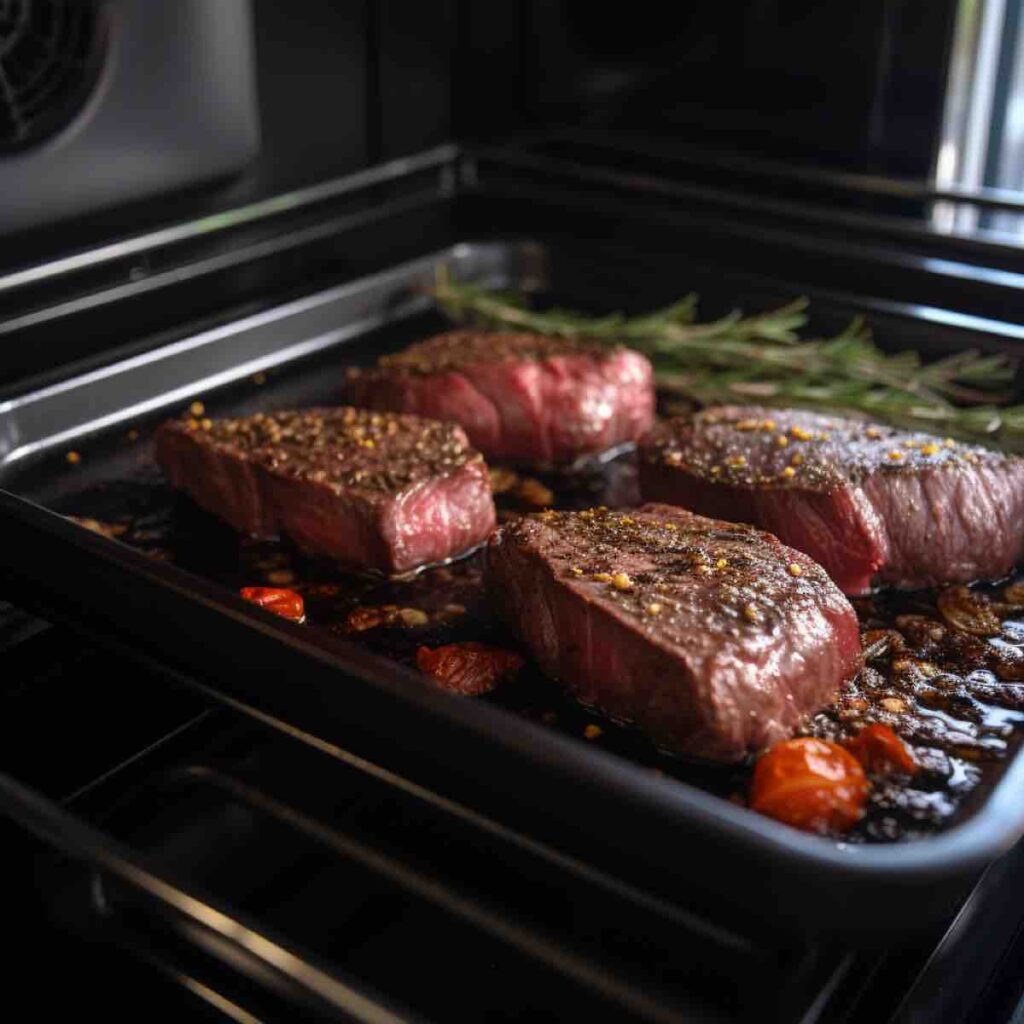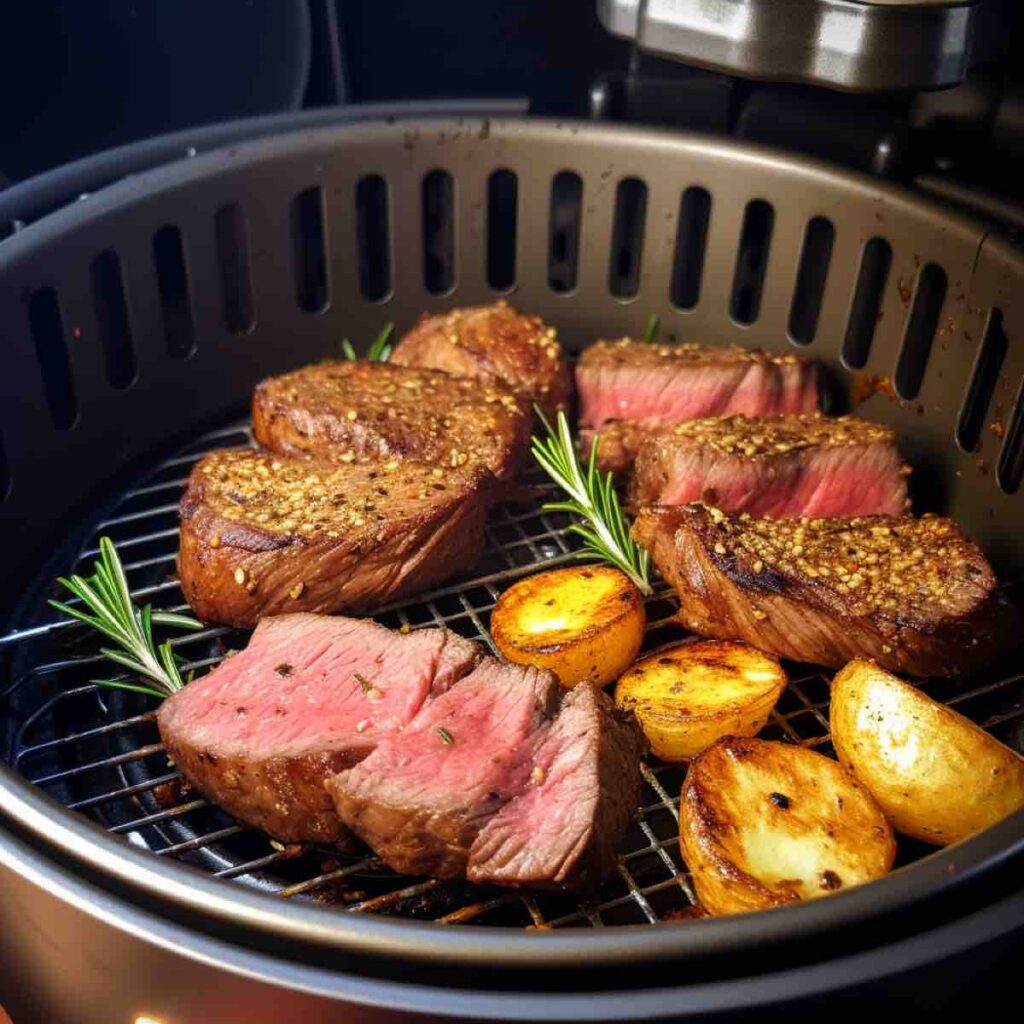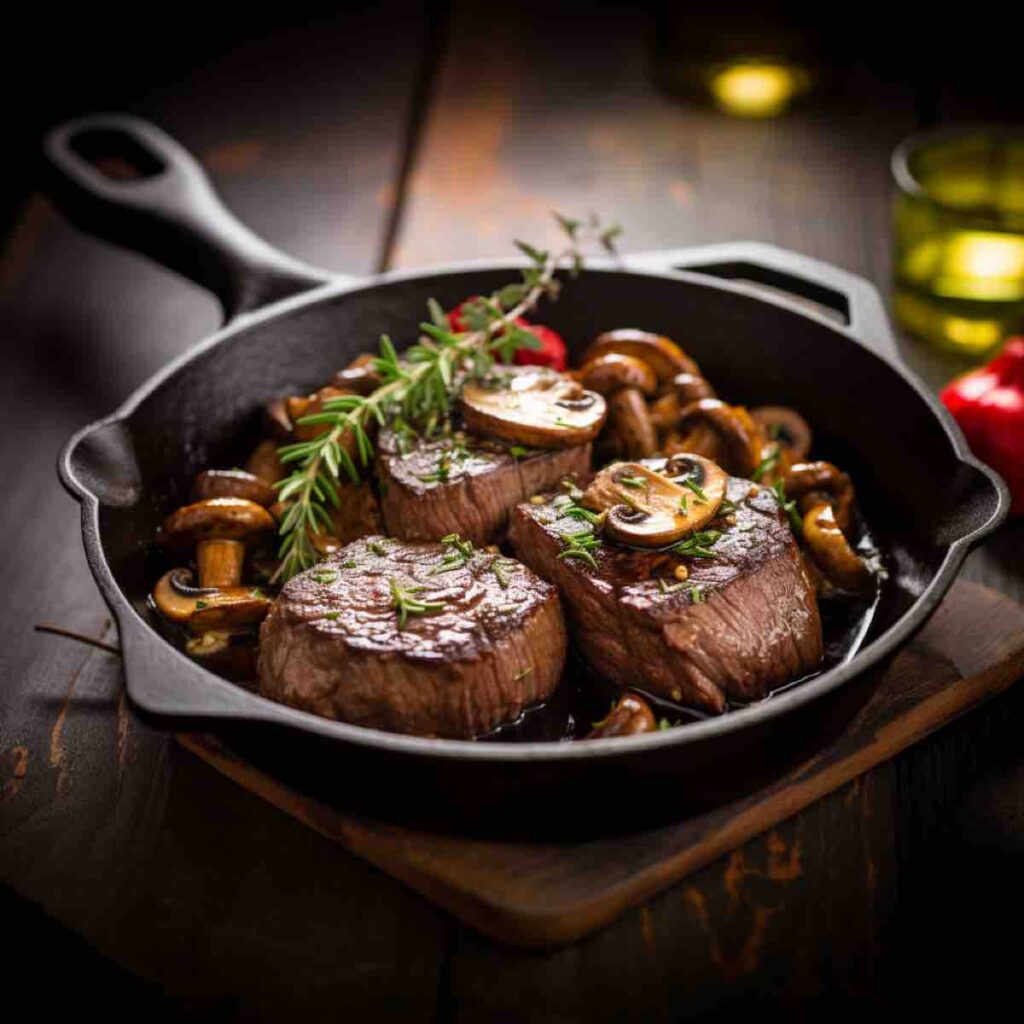Reheating beef tenderloin can be daunting since this particular cut of meat is delicate and known for its juiciness and tenderness. It’s essential to preserve these qualities when warming it up; thankfully, a few proven methods can help you achieve this.
This article will explore the best ways to reheat beef tenderloin, focusing on maintaining its texture and succulence without overcooking or drying it out.
I should also mention the portion size per person for beef tenderloin can be found here.
Understanding the importance of temperature control, preparing the meat correctly, and using the appropriate reheating methods can make all the difference to getting a reheated beef tenderloin (or leftover steaks) that is as good as a fresh juicy steak.
Paying attention to these factors will help you enjoy a delicious, tender piece of meat even when it’s not fresh off the grill or oven.
While there are different cuts of meat, the methods are similar for many cuts of steak. However, one point to keep in mind is a 1-inch steak will need a different method than a thinner steak.
See how to cook ribeye steak in a pressure cooker.
Key Takeaways
- The best way of reheating a tenderloin steak is in the oven on low heat for about 30 minutes at no more than 100 degrees. Next, use a hot skillet to sear the outside on medium-high heat using butter for about 1.5 minutes and then turn to the other side.
- The skillet or Oven Method is the best reheating method to maintain tenderness and juiciness.
- Properly prepare the meat and closely monitor temperature during reheating
- Use a steak sauce to keep the steak moist.

Best Reheating Methods
Using an Oven
To reheat your beef tenderloin in the oven, let it come to room temperature first. Preheat your oven to 250°F (120°C) and wrap the meat in foil after drizzling 1-2 tablespoons of meat juice or stock over it. Place the wrapped beef tenderloin on a wire rack on a rimmed baking tray. Using a meat thermometer, heat until the internal temperature reaches at least 140°F (60°C). This usually takes 10-15 minutes. Allow the meat to rest before serving, which will help retain its moisture and flavor.
Using a Stovetop Skillet
Reheating beef tenderloin on a stovetop skillet is another great option. First, let the meat come to room temperature.
Heat a skillet with a bit of butter, vegetable, or olive oil over medium-low heat. Once the pan is hot, add the tenderloin and sear for a few minutes on each side. Monitor the internal temperature with a meat thermometer to prevent overcooking. Allow the meat to rest for a few minutes before serving.

Using an Air Fryer
An air fryer can be a convenient way to reheat beef tenderloin. Before using the air fryer, let your beef tenderloin reach room temperature.
Preheat the air fryer to 360°F (180°C). Place the tenderloin in the basket, being careful not to overcrowd it.
Reheat for 3-5 minutes, checking the internal temperature with a meat thermometer. Aim for an internal temperature of 140°F (60°C) for medium-rare. Allow the meat to rest for a few minutes before serving.
Using a Sous Vide
Reheating beef tenderloin using a sous vide method allows for precise temperature control, reducing the risk of overcooking. First, vacuum-seal your tenderloin in a plastic bag. Set the sous vide water bath to 140°F (60°C) for medium.
Place the bag in the water for about 30 minutes, ensuring the internal temperature reaches the desired level. After reheating, carefully pat the meat dry and give it a quick sear in a hot skillet with some butter or oil to add flavor and color. Allow the meat to rest for a few minutes before serving.
Using a Microwave
Although not the preferred method, reheating beef tenderloin in a microwave is possible when short on time. However I prefer to use this method as a last resort.
Place the tenderloin on a microwave-safe plate and cover it with microwave-safe plastic wrap, leaving a small vent for steam to escape. Reheat the meat in the microwave on a low power setting in 30-second intervals to prevent overcooking, checking the internal temperature with a meat thermometer.
Aim for an internal temperature of 140°F (60°C) for medium-rare.
Preparing the Meat for Reheating
Thawing the Frozen Beef Tenderloin
Before you plan to reheat your leftover pieces of meat, ensure that it is properly thawed.
Ideally, let the meat sit in the refrigerator for several hours to thaw out gradually. Avoid using a microwave to thaw the beef meat, as it might cause the meat to become unevenly heated. It will then certainly not be a perfect meal.
Remember, if your tenderloin is still frozen or partially frozen, reheating it will be more challenging and can result in unevenly cooked meat.

Preserving Flavor and Moisture
It is essential to preserve its wonderful flavor and moisture to yield the best results when reheating beef tenderloin.
Drizzle a small amount of cooking juices or leftover stock (this will enhance the beefy flavor) over the beef before reheating. This helps to retain moisture during the reheating process and prevents the meat from drying out and destroying the connective tissue.
Finally, apply a light seasoning like freshly ground black pepper and kosher salt to enhance the desired flavor. Use this preparation method for your leftover beef tenderloin to ensure it tastes just as delicious during the second serving.
The Importance of Temperature
When reheating beef tenderloin, managing temperature is crucial. Paying attention to temperature levels will maintain the meat’s tenderness, juiciness, and deliciousness. This section focuses on the role of temperature while reheating beef tenderloin and highlights two key aspects to consider: using a meat thermometer and finding the right temperature levels.
Using a Meat Thermometer
A meat thermometer is essential for ensuring your beef tenderloin is reheated to the perfect temperature. Insert the thermometer into the thickest part of the meat to gauge its internal temperature. This will help you monitor the meat’s progress and prevent overcooking or undercooking. Remember, overcooked beef tenderloin can become dry and tough, while undercooked meat might pose health risks.
Finding the Right Temperature Levels
When reheating beef tenderloin in your oven, it’s vital to find the right temperature levels for the best results. Here are some guidelines to follow:
- Preheat your oven to a low temperature, ideally between 250-300°F (120-150°C).
- Bring your beef tenderloin to room temperature before placing it in the oven. This helps to ensure even cooking.
- Monitor the internal temperature of the meat using your meat thermometer. Aim for approximately 130°F (54°C) for medium-rare, 135°F (57°C) for medium, or 145°F (63°C) for medium-well.
- Once your beef tenderloin reaches the desired internal temperature, remove it from the oven and let it rest for a few minutes before serving. This allows the juices to redistribute throughout the meat, enhancing its flavor and texture.
Tips to Avoid Overcooking
When reheating beef tenderloin, one of the main challenges you face is avoiding overcooking. To help you achieve a perfect reheated tenderloin, follow these tips focusing on low temperature and proper monitoring techniques.
Use Low Temperature: Cooking at a lower temperature ensures that your beef tenderloin heats evenly, retaining its texture and flavor. Higher temperatures will lose moisture, making the meat dry and less enjoyable.
Monitor Internal Temperature: Pay close attention to the meat’s internal temperature to prevent overcooking. Use a meat thermometer to check that your beef is warmed through without being overcooked.
Depending on the size and thickness of the meat, the reheating process will vary a little. If you don’t have a meat thermometer, you can use a sharp knife to poke the meat and confirm even heating.
Following these tips will help you enjoy a delicious, perfectly reheated beef tenderloin while avoiding the challenges of overcooking. Remember to maintain a low temperature, monitor the internal temperature, store the beef properly, and explore alternative methods for the best results.
Serving Suggestions For Reheated Beef Tenderloin
Creating Complementary Sauces and Gravies
To enhance the flavor of your reheated beef tenderloin, a well-paired sauce or gravy can make all the difference.
Bearnaise sauce is a favorite. Another popular option is a red wine reduction that combines red wine, beef broth, and shallots, simmered until thick and rich in flavor.
If you prefer something on the lighter side, give Chimichurri a try: This is a blend of parsley, cilantro, garlic, vinegar, and olive oil for a bright and zesty finish.
Pairing with Vegetables and Sides
Your beef tenderloin deserves to be accompanied by equally delicious sides to create a well-rounded meal. For a burst of color and flavor, consider the following vegetable dishes:
- Roasted root vegetables: combine baby carrots, parsnips, and beets tossed in olive oil, salt, and pepper, then roasted until tender and caramelized.
- Garlicky green beans: stir fry green beans with garlic, olive oil, and a pinch of red pepper flakes for a quick, yet flavorful side.
- Mashed sweet potatoes: boil and mash sweet potatoes with butter, cream, and a hint of cinnamon for a creamy and slightly sweet side dish.
Frequently Asked Questions
How can I reheat beef tenderloin without drying it out?
To reheat beef tenderloin without drying it out, you can use the oven and skillet methods. First, preheat your oven to 300°F, and wrap the beef in aluminum foil. Then, heat a skillet with some oil or butter and sear the steak to seal in the buttery juices.
What’s the best method to reheat a whole beef tenderloin roast?
The oven is the best method to reheat a whole beef tenderloin roast. Preheat your oven to 300°F and wrap the roast in aluminum foil. Place it on a roasting pan and cook for about 10-15 minutes or until the internal temperature reaches 130°F. This method will ensure the tenderloin remains moist and retains its original flavor. When the steak is resting, pour over extra juices, as it will ensure a perfect summer meal.
How can I reheat beef and maintain its moisture?
Using the sous vide technique is ideal to reheat beef and maintain its moisture. Place the beef tenderloin in an airtight, heat-safe bag and immerse it in a temperature-controlled water bath at about 130°F. Leave it in for 30-45 minutes; the gentle reheat process will keep the beef moist.
What is the correct reheating technique for rare beef?
The sous vide technique is the most suitable for reheating rare beef as it gently warms the meat without overcooking it. Place the beef in an airtight, heat-safe bag and immerse it in a water bath with a temperature of 120-125°F. Keep the beef in the bath for around 30 minutes to maintain its rare state while reheating.
Can I use an air fryer to reheat beef tenderloin?
Yes, you can use an air fryer to reheat beef tenderloin. Preheat the air fryer to 350°F and cook the beef for about 3-5 minutes or until it reaches the desired internal temperature. It’s important to remember air fryers can cook quickly, so monitoring the beef is essential to prevent overcooking.
Is it possible to reheat filet mignon on the stove?
Reheating filet mignon on the stove is possible. First, allow the filet mignon to come to room temperature. Heat a skillet over medium heat with a tablespoon of oil, then add the filet mignon. Cook for about 2-3 minutes per side or until the internal temperature reaches the desired level. Rest the meat briefly before serving to maintain tenderness and juices.